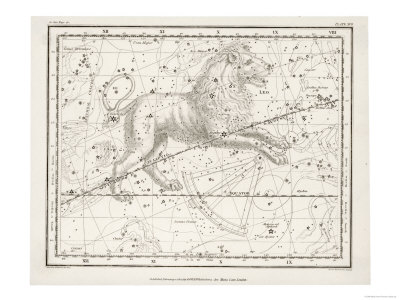In the Neighborhood of the "Little King"
Regulus, the brightest star in the constellation Leo, lies at the base
of an easy to find figure of stars (or asterism) known as "The Sickle."
These stars form the head and chest of a reclining westward-facing lion.
Regulus means "Little King" in Latin but has at times also been known as
Cor Leonis, "The Heart of the Lion." Use the sky map to find "The
Sickle." It looks like a backward question mark high up in the southern
sky. Can you see the pattern of six stars?

Click Here for Information or to Buy this Print
A few degrees north of Regulus (on the sickle) lies the seemingly
inconspicuous star known as Eta Leonis. It is in fact a hot white
supergiant star over 15,000 times more luminous than our Sun. Eta Leonis
appears fainter than Regulus because it is nearly 30 times further away
from us than Regulus. If Eta Leonis were at the same distance as Regulus
(77 light years) it would appear almost as bright as Venus and outshine
every other star in the night sky. If it were the same distance as
Sirius (8.6 light years) it would appear 50 times brighter than Venus
and be visible even in the daytime!
Near the paw of the great lion, about 5 west of Regulus, lies another
inconspicuous star that shines bright for only a few days each year. The
star is known as R Leonis, a red giant variable star that changes
brightness as it undergoes a periodic expansion and contraction in size.
It steadily brightens and fades between about magnitudes 5 and 10 over a
period of 312 days.
This year R Leonis is expected to reach maximum brightness around late
April or early May. Use binoculars to observe its distinct reddish glow
over a period of a few weeks. R Leonis may even become visible to the
unaided eye.
The Planets in April
Jupiter, Saturn and Mars are visible close together and very low in the
western sky. The crescent Moon will join them on 6 April. Sky watchers
in Japan and Australia will see the Moon cross in front of the Hyades
star cluster on the evening of 8 April. Clear skies until next month!
Related Links:
Related Books:


